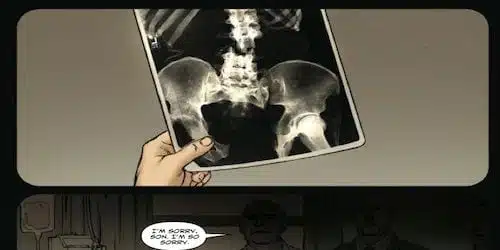
Stan Lee’s most recent endeavor is a partnership with BOOM! Studios in crafting an all new superhero universe with thoroughly modern sensibilities. The legendary comic book personality has already crafted one such universe that is now a worldwide empire of popular entertainment. Does this new Stan Lee-verse, although only in its infant stages, have the legs to make it alongside Lee’s prolific career at Marvel Comics?
Soldier Zero is the first debut in this universe building exercise. Writer Paul Cornell, of Doctor Who and Action Comics fame, and artist Javier Pina are behind the wheel of this series which is an extrapolation of concepts generated by Lee. The style of creation is classic 1960’s Marvel. Lee has his name and face associated with so many characters due to his patented writing style. Lee would hash out a rough outline with an artist. There would be no written script, just notes and ideas that were left up to the artist to decipher. Despite this Silver Age style of creation, there is something unmistakably modern about Soldier Zero.
The story focuses on Stewart, a Middle American man confined to a wheel chair. His injury stems from a war wound suffered while in Afghanistan. Into this mix comes the mysterious Soldier Zero, an enigmatic alien symbiotic war machine that is battling an unnamed foe above Earth. Although from the first several pages it is clear the paths of these two warriors will cross, the way in which they are juxtaposed is interesting to note.
Stewart, while depicted with a cheery exterior, is far more complex than that. He hides a frustration that burns deep down inside of him. There are echoes of Born on the Fourth of July in Stewart’s story. He even contemplates speaking out against the war in Afghanistan at one point. However, his anger is more personalized. His frustrations stem from his treatment. While Stewart’s well meaning older brother, James, tries to keep his spirits up, his efforts are ultimately patronizing. The girl who Stewart has an interest in spends most of her time apologizing to him. Even the sidewalks of Middle America prove to be challenges. Stewart, in frustration, finally exclaims “It’s not me that’s broken, it’s all this!”
Stewart’s counterpart in this first issue is an enigmatic alien war suit. After an intense battle above the planet, it falls, broken and damaged, only to land on top of the equally damaged Stewart. The two meet because of their injuries. Stewart is in the way of the alien visitor due to his wheelchair. Disability unites the two halves into a new whole.
This takes Stewart into an interesting place. The broken man, although hiding is pain, clearly scoffs at those who call him a war hero. “I wasn’t a hero. I was just doing my job. I got nailed. But I’m tired of being an arms-bearer. I’m not sure there’s ever a good reason to be,” Stewart tells his brother. However, merging with the alien suit and becoming Solider Zero has granted, as it appears in this first issue, Stewart the ability to walk again. Nevertheless, the alien battle suit is clearly a weapon for war. He has become a living piece of armament that he must now bear.
His new found power has become his curse. Such a statement echoes a much earlier creation of Stan Lee’s. After all these years, Lee is still able to craft concepts that are as endearing as his earlier work. With the title’s modern sensibilities to storytelling there are also nuggets of timeless qualities to be found. While Cornell and Pina provide the heavy lifting that makes this new debut standout it is nevertheless the messages written across the book that are clearly and quintessentially Lee. The broken everyman is granted power that heals but also the power to destroy. The dual nature of special abilities is the hallmark of this comic legend.
Solider Zero is a strong debut from BOOM! Studios. The strong pairing of Cornell’s penchant for dialogue and characterization and Pina’s slick modern storytelling has paid off. The real standout is Stan Lee though. His creation of a new shared universe already appears to be off to a good start. Lee’s ability to instill timeless tropes into modern comics is still as sharp as ever. Chalk this up as another success for Stan ‘The Man’ himself.
